Extra Questions for Class 10 Science Chapter 6 Life Processes
Get extra questions for Class 10 Science Chapter 6 Life Processes with PDF. Our subject expert prepared these solutions as per the latest NCERT textbook. These extra questions will be helpful to revise the important topics and concepts. You can easily download all the questions and answers in PDF format from our app.
Life Processes Class 10 Science Extra Questions with Answers
Question 1: Mention the raw materials required for photosynthesis.
Answer: The following raw materials are required for photosynthesis:
(i) Carbon Dioxide: Plants get CO2 from atmosphere through stomata.
(ii)Water: Plants absorb water from soil through roots and transport to leaves.
(iii) Sunlight: Sunlight, which is absorbed by the chlorophyll and other green parts of the plant.
Question 2: What would be the consequences of deficiency of haemoglobin in your body?
Answer: The deficiency of haemoglobin in our body is called anaemia. In anaemia, the blood is unable to carry the sufficient amount of oxygen required by the body. So, respiration would be less and less energy will be available to the body. The haemoglobin deficient person will feel weak, pale, lethargic and will be unable to perform heavy physical work.
Question 3: Name the green dot like structures in some cells observed by a student when a leaf peel was viewed under a microscope. What is this green colour due to?
Answer: The green dot-like structures in some cells observed by a student when a leaf peel is viewed under a microscope are chloroplasts. The green colour is due to the presence of green pigment, chlorophyll.
Question 4: State any one difference between autotrophic and heterotrophic modes of nutrition.
Answer: In autotrophic nutrition, organisms obtain their food from inorganic substances. In heterotrophic nutrition, organisms derive their food from organic substances.
Question 5: A Give one reason why multicellular organisms require special organs for exchange of gases between their body and their environment.
Answer: In unicellular organisms the entire body of the organism is in contact with the environment hence exchange of materials can take place but, in multicellular organisms the entire body of the organism is not in contact with the environment and hence simple diffusion is not helpful.
Question 6: Name the process in plants where water is lost as water vapour. :
Answer: Transpiration is the process when plants loose water as vapour.
Question 7: What is translocation in plants?
Answer: Translocation is the movement of soluble materials, products of photosynthesis from leaves to other tissues throughout the plant.
Question 8: State the basic difference between the process of respiration and photosynthesis.
Answer:
| Cellular Respiration | Photosynthesis |
| Occurs in all living organisms. | Occurs only in phototrophs (all green plants, algae, and some bacteria). |
| The entire process occurs in Mitochondria. | The entire process occurs in Chloroplasts. |
| Glucose and oxygen are the reactants of this process. | Carbon dioxide, water, and light energy are the reactants of this process. |
| Carbon dioxide, water, and energy (ATP) are the by-products. | Glucose, oxygen, and water are the by-products. |
| Undergoes Catabolic Process. | Undergoes Anabolic Process. |
| Oxygen is taken in and carbon dioxide is liberated out. | Producing food and capturing energy. |
| In this process, food particles are broken down to release energy. | In this process, food is synthesized by capturing energy. |
| It is an exergonic reaction as energy is released. | It is an endothermic reaction as it requires energy. |
| This process does not require sunlight since cellular respiration occurs all the time. | This process requires sunlight since photosynthesis occurs only in the presence of sunlight. |
| The chemical reaction of cellular respiration is C6H12O6 + 6O2 → 6CO2 + 6H2O | The chemical reaction of photosynthesis is 6CO2 + 6H2O → C6H12O6+ 6O2 |
Question 9: In the experiment “Light is essential for photosynthesis”, why does the uncovered part of the leaf turn blue-black after putting iodine solution?
Answer: Starch is produced in the uncovered part of the leaf because it is exposed to sunlight allowing it to photosynthesize, which turns blue-black in presence of iodine solution.
Question 10: Name the component of blood that helps in the formation of blood clot in the event of a cut.
Answer: Platelets help in clotting of blood in the event of a cut.
Question 111: Mention how organisms like bread moulds and mushrooms obtain their food.
Answer: Organisms like bread moulds and mushrooms breakdown the food materials outside the body and then absorb the nutrients of the bread.
Question 12: What will happen to a plant if its xylem is removed?
Answer: Xylem in plant transports water and dissolved mineral nutrients from the roots to all parts of the vascular plant. So, if xylem is removed from the plant, the water and mineral supply to the plant will stop and therefore, the plant will die.
Question 13: Where does digestion of fat take place in our body?
Answer: Digestion of fat takes place in the small intestine of our body.
Question 14: What is the mode of nutrition in human beings?
Answer: Holozoic nutrition.
Question 15: What are enzymes? Name any one enzyme of our digestive system and write its function.
Answer: Enzymes are biological catalysts. Catalysts are proteins that increase the rate of chemical reactions without being used up. For example: Amylase catalyses the breakdown of starch into sugars in the mouth and small intestine
Question 16: (i) Write the balanced chemical equation for the process of photosynthesis,
(ii) When do the desert plants take up carbon dioxide and perform photosynthesis?
Answer: (i) Photosynthesis can be represented using a chemical equation. The overall balanced equation is

(ii) Desert plants open up their stomata during night and take in CO2. Stomata remains close during the day time to prevent the loss of water by i transpiration. They store the CO2 in their cells until the sun comes out and they can carry on with photosynthesis during the day time.
Question 17: Why do herbivores have longer, small intestine than carnivores?
Answer: Digestion of cellulose takes a longer time. Hence, herbivores eating grass need a longer small intestine to allow complete digestion of cellulose. Carnivorous animals cannot digest cellulose due to the absence of enzyme cellulose hence they have a shorter intestine.
Question 18: Why do the walls of the trachea not collapse when there is less air in it?
Answer: Rings of cartilages are present in trachea. These rings support the trachea and do not allow the trachea to collapse when there is less air in it.
Question 19: What are the final products after digestion of carbohydrates and proteins?
Answer: The final product produced after digestion of carbohydrates is glucose and of proteins is amino acids.
Question 20: What is saliva? State its role in the digestion of food.
Answer: Saliva is a watery fluid secreted by the salivary glands in the mouth. The digestive functions of saliva include moistening food, and helping to create a food bolus, so it can be swallowed easily. Saliva contains the enzyme amylase that breaks some starches down into maltose and dextrin.
Question 21: Explain the process of nutrition in Amoeba.
Answer: Amoeba is a protozoan found in fresh water. It feeds on microscopic plants and animals present in water. The mode of nutrition in amoeba is Holozoic. And the process of obtaining food by amoeba is called phagocytosis. The different processes involved in the nutrition of amoeba are:
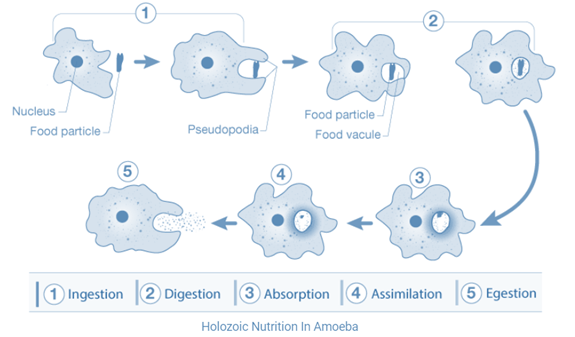
Ingestion: Ingestion is the process of taking food in the body. Amoeba is a unicellular animal, so it doesn’t have a mouth for ingestion of food. Amoeba ingests the food by encircling it by forming pseudopodia. When the food is completely encircled, the food is engulfed in the form of a bag called food vacuole.
Digestion: Digestion is the process of breaking the large and insoluble molecules in small and water soluble molecules. In amoeba, several digestive enzymes react on the food present in the food vacuoles and break it down into simple and soluble molecules.
Absorption: The food digested by digestive enzymes is then absorbed in the cytoplasm by the process of diffusion. While the undigested food remains in the food vacuole. If a large amount of food is absorbed by amoeba, the excess food is stored in the cytoplasm in the form of glycogen and lipids.
Assimilation: During this step the food absorbed by the cytoplasm is used to obtain energy, growth and repair. This process of utilizing absorbed food for obtaining energy, repair and growth is called assimilation.
Egestion: When a sufficient amount of undigested food gets collected in the food vacuole, it is thrown out of the body by rupturing cell membrane. The process of removal of undigested food from the body is called egestion.
Question 22: State differences between arteries and veins.
Answer:
| Arteries | Veins |
| Involved in carrying pure, oxygenated blood and nutrient-rich blood. | Involved in carrying impure, deoxygenated blood |
| Consists of three distinct layers, which are rigid, thicker and highly muscular. | Consists of three distinct layers, which are thin and collapsible. |
| Located deep within the body. | Peripherally located closer to the skin. |
| Red in colour. | Blue in colour. |
| Carry blood away from the heart to various parts of the body. | Carry blood towards the heart from the various parts of the body. |
| High pressure, as the blood flows by the pumping pressure of the heart. | Low pressure, as the blood flows by the capillary action of the veins. |
| Comparatively higher oxygen level. | Comparatively low oxygen level. |
| The level of carbon dioxide is low | The level of carbon dioxide is high |
| In downward direction from the heart to the body tissues. | In upward direction from the body tissues to the heart. |
| Lumina is narrow. | Lumina is wide. |
| Valves are absent | Valves are present |
| Arteries are at a greater risk of certain diseases like angina pectoris, atherosclerosis, etc. | Veins are less susceptible to diseases such as varicose veins. |
Question 23: How are the alveoli designed to maximise the exchange of gases?
Answer: Alveoli are small pouches or sacs like structure. They are surrounded by blood capillaries. Thus a large amount of air is brought in contact with the air in the lungs. More than millions of alveoli are present in the lungs. The presence of millions of alveoli in the lungs provides a very large surface area for the exchange of gases. The availability of large surface area maximises the exchange of gases.
Question 24: Name two excretory products other than O2 and CO2 in plants.
Answer: The two excretory products other than O2 and CO2 in plants are resins and gums.
Question 25: In single celled organisms diffusion is sufficient to meet all their requirements of food, exchange of gases or removal of wastes but it is not in case of multicellular organisms. Explain the reason for this difference.
Answer: Unicellular organisms can absorb sufficient oxygen because of its complete
contact with the atmosphere, but in multicellular organisms the rate of absorption and diffusion becomes very less because all cells are not in direct contact with the atmosphere. Multicellular organisms require greater amount of oxygen to sustain life processes which cannot be fulfilled by the process of diffusion.
Question 26: Draw a diagram of human excretory system and label kidneys, ureters on it.
Answer:
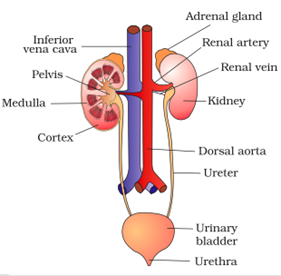
Question 27: Name the acid presents in the following:
(i) Tomato (ii) Vinegar (iii) Tamarind
Answer: (i) Oxalic acid (ii) citric acid (iii) Tartaric acid.
Question 28: State the role of the following in human digestive system:
(i) Digestive enzymes (ii) Hydrochloric acid (iii) Villi
Answer: (i) Digestive enzymes – Foods need to be broken into their small or simpler molecules so that they can be absorbed into the bloodstream. However, the physical breakdown of food is not enough. Enzymes are hence needed for the chemical breakdown of food and speeding up the digestive process. The products of digestion can hence be small enough to be absorbed.
(ii) Hydrochloric acid – Hydro chloric acid helps to kill the germs which might have entered in to the system through food. It creates acidic medium for the pepsin to act on food to breakdown proteins.
(iii) Villi – Villi are finger like projections in the small intestine. They help to increase the surface area for absorption of the digested food. Villi are richly supplied with blood vessel which help to absorb digested food in to the blood stream.
Question 29: In mammals and birds why is it necessary to separate oxygenated and de-oxygenated blood?
Answer: Mammals and birds are warm blooded animals. This means they can control their body temperature and do not have to depend on environment for their body temperature regulation. Because of this birds and mammals require optimum oxidization of glucose which would be possible with good supply of oxygen. So it is required to have separate oxygenated and de-oxygenated blood to supply the required amount of oxygen.
Question 30: Draw a diagram of human respiratory system and label it.
Answer:
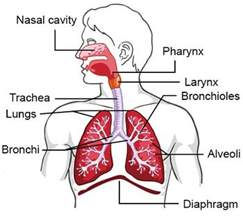
Question 31: (a) Name the site of exchange of material between the blood and surrounding cells.
(b) Draw a schematic representation of transport and exchange of oxygen and carbon dioxide in human body.
Answer: (a) Capillaries
(b)
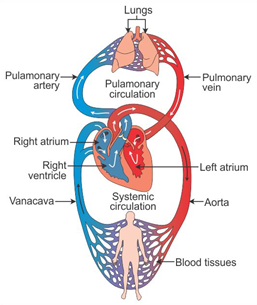
Question 32: List three characteristics of lungs which make it an efficient respiratory surface.
Answer: These features which particularly make our lungs efficient for gas exchange.
- Thin: the air sac walls are very thin so that gases can quickly diffuse through them. Oxygen is absorbed in to the blood and carbon dioxide is given out in to the lungs to be exhaled out.
- Moist: the air sacs are moist with mucus so that gases can dissolve before diffusing.
- Large surface area: the surface area for gases to diffuse through in human lungs is roughly the same as a tennis court. The alveoli help to increase the surface area for absorption of oxygen.
- Good blood supply: the air sacs or the alveoli have a large capillary network so that large volumes of gases can be exchanged. More the flow of blood more exchange.
Question 33: (a) What is the role of HCl in our stomach?
(b) What is emulsification of fats?
(c) Which protein digesting enzyme is present in pancreatic juice?
Answer: (a)(i) It sterilises food by killing pathogens and other microbes.
(ii) It has a pH of 2, which is perfect for entyaus such as pepsin to break down proteins as effectively as possible.
(iii) Helps emulsify food (digestion of protein and stimulates the pancreas to produce digestive enzymes and bile) and protects against harmful bacteria.
(b) Breakdown of large globule fats into smaller fats droplets is known as emulsification.
(c) Trypsin is the enzyme secreted by the pancreas which aids in digestion of proteins.
Question 34: In human alimentary canal, name the site of complete digestion of various components of food. Explain the process of digestion.
Answer: In small intestine, complete digestion of various components of food take place. The process of digestion of food in mouth, stomach and small intestine in human body are as follows:
Mouth: Digestion of food begins in the mouth. Saliva present in mouth contains a digestive enzyme, called salivary amylase, maltose and dextrin, which breaks down starch into sugar.
Stomach: Stomach stores and mixes the food received from the oesophagus with gastric juices. The main components of gastric juice are hydrochloric acid, mucus and pepsinogen. Hydrochloric acid dissolves bits of food and creates an acidic medium. In this medium, pepsinogen is converted to pepsin which is a protein-digesting enzyme. Mucus protects the inner lining of the stomach from the action of HCl.
Small Intestine: Small intestine is the site of complete digestion of carbohydrates, proteins and fats. Small intestine produces intestinal juice from the glands present in its wall. The intestinal juice helps in further digestion of food. Small intestine also obtains digestive juices from liver and pancreas. The liver produces bile juice that causes emulsification of fats and the pancreas produces pancreatic juice for digesting proteins and emulsified fats. This digested food is finally absorbed through the intestinal walls.
Question 35: (a) “The breathing cycle is rhythmic whereas exchange of gases is a continuous process”. Justify this statement.
(b) What happens if conducting tubes of circulatory system develops a leak? State in brief, how could this be avoided?
(c) How opening and closing of stomata takes place?
Answer: (a) The breathing cycle involves inhalation and exhalation of air due to alternate expansion and contraction of thoracic cavity. Thus, it is a rhythmic process. But exchange of gases is a continuous process as it takes place between the blood and each and every cell, by diffusion.
(b) The circulatory system will become inefficient if it develops a leak. This could be avoided by maintaining a normal blood pressure.
(c) When water flows into the guard cells, the guard cells swell and the stomatal pore opens up. When water moves out the guard cells shrinks and the stomatal pore closes.
Question 36: Describe in brief the function of kidneys, ureters, urinary bladder and urethra.
Answer: The Kidneys filter the blood and concentrate the filtrate to make urine. They also help regulate blood pressure. Ureters transport the urine to the urinary bladder. Urinary bladder is like a holding tank for the urine until it’s ready to be excreted. Urethra is the tube that connects the urinary bladder to the outside of the body for excretion.
Question 37: Explain the process of breakdown of glucose in a cell (ii) in the absence of oxygen.
Answer: The process of breakdown of glucose in a cell are as follows:
The first step in the breakdown of glucose both in presence of O2 and in absence of O2 is same. In this step, glucose is broken down into pyruvate.
Second step which involves further breakdown of private into simple compounds can take place in two different ways:
(i) In presence of O2: In the presence of O2, private is converted into CO2 and water. Energy released during aerobic respiration is much greater than that released during an anaerobic respiration.
(ii) In absence of O2: In the absence of O2 in yeast, pyruvate is converted into ethanol and CO2 and the process is called fermentation. In absence of O2, in our muscle cells, pyruvate is converted into lactic acid. The build up of lactic acid in muscle cells causes cramps.
Question 38: (a)Explain how does the exchange of gases occur in plants across the surface of stems, roots and leaves.
(b) How are water and minerals transported in plants?
Answer:
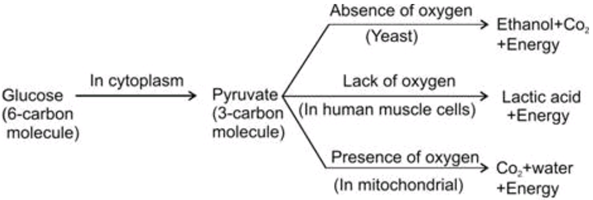
(a) In plants there are tiny pores called stomata on leaves and lenticels in stem which facilitate the exchange of gases. Carbon dioxide is taken in and oxygen given out {during photosynthesis} and vice versa during respiration.
(b) Water and minerals are transported within the plant by the Xylem vessels (mainly in an upward direction); these are part of the vascular system which also includes Phloem vessels. Phloem transports the products of photosynthesis within the plant, to all parts like the stem, roots, fruits etc. in all directions.
Question 39: State in brief the function of:
1. renal artery
2. kidney
3. ureter
4. urinary bladder
Answer: Renal artery: The renal artery carries blood to the kidneys from the abdominal aorta. This blood comes directly from the heart and is sent to the-kidneys to be filtered before it passes through the rest of the body. Up to one-third of the total cardiac output per heartbeat is sent to the renal arteries to be filtered by the kidneys. Each kidney has one renal artery that supplies it with blood. The filtered blood then can exit the renal vein.
Kidney: The kidneys perform the essential function of removing waste products from the blood and regulating the water fluid levels. The kidneys regulate the body’s fluid volume, mineral composition and acidity by excreting and reabsorbing water and inorganic electrolytes.
Ureter: The ureter is a tube that carries urine from the kidney to the urinary bladder.’ There are two ureters, one attached to each kidney.
Urinary bladder: The urinary bladder is an expandable muscular sac that stores urine before it is excreted out of the body through the urethra.
Question 40: How is urine produced and eliminated?
Answer: Blood from the heart comes into the kidneys afferent and efferent arteriole from the renal arteries where it enters about 2-3 million nephrons per kidney. Then, it goes through the glomerulus a tuft or bunch of blood capillaries and get rid of some of the unwanted substances like urea, uric acid, creatinine in the blood and then continues through the renal tubules. The loop of Henley, reabsorb certain substances such as water (actually if body is dehydrated, body will send antidiuretic hormone (ADH) to kidneys to prevent extra water from going into urine and thus saving water for body and get rid of anything else that isn’t wanted, then the urine goes through ureters to bladder and then to urethra where it is excreted out of body as urine.
Question 41: (a) Draw a diagram to show open stomatal pore and label on it:
(i) guard cells
(ii) chloroplast
(b) State two functions of stomata.
(c) How do guard cells regulate the opening and closing of stomatal pore?
Answer: (a)
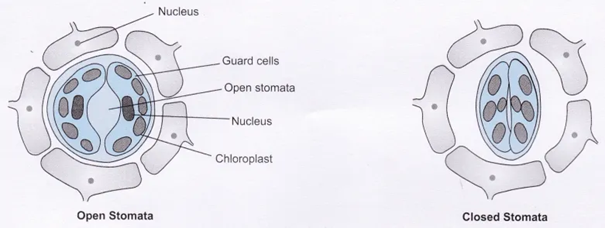
(b) Two functions of stomata are:
(i) Exchange of gases between the plant and the atmosphere takes place through stomata.
(ii)Transpiration in plants takes place through stomata.
(c) Opening and Closing of Stomatal Pore: The opening and closing of the pore is a function of the guard cells. The guard cells swell when water flows into them causing the stomatal pore to open. Similarly, the pore closes if the guard cells shrink. As large amount of water is lost through these stomata, the plant closes these pores when it does not require carbon dioxide for photosynthesis.
Question 42: Why is the rate of breathing in aquatic organisms much faster than in terrestrial organisms?
Answer: Quantity of dissolved oxygen is fairly low in water as compared to the amount of oxygen in air. Aquatic organisms therefore have to breath faster than terrestrial organisms to absorb the required amount of oxygen from the water.